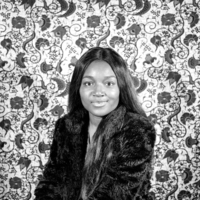
N. D-Nkufi
N. Diansunzuka-Nfuki Kingston Upon Thames, UK 1st Generation British born Congolese, London
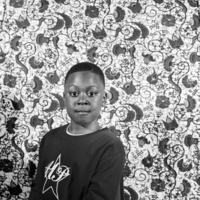
J. Mundeke
J. Mundeke, Kingston Upon Thames, U.K. 1st Generation British born Congolese/Angolan, London
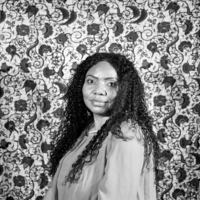
Ma J.M. Kilapi
Ma J.M. Kilapi, D.R. Congo 1st Generation Congolese/Angolan, London
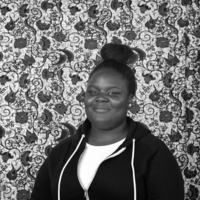
S.S. Mundeke
S.S. Mundeke, Kingston Upon Thames, UK 1st Generation British Born Congolese/Angolan, London.
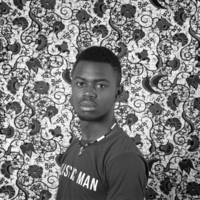
O.M. Kitenge
O.M. Kitenge, D.R. Congo. 2nd Generation Congolese, London.
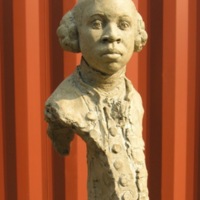
OLAUDAH EQUIANO - African, slave, author, abolitionist
This sculpture of the abolitionist Olaudah Equiano was made by London-based sculptor Christy Symington in 2006 to mark the bicentenary of the abolition of the British transatlantic slave trade, with the intent to further share Equiano's story. It was first exhibited by selection at the Society of Portrait Sculptors 'FACE 2007' annual exhibition. The sculpture portrays Olaudah Equiano’s social standing through his clothing and hairstyle which was unusual for a black man in that time. The continent of Africa is implied by the shape of the back of his shoulders arrived at by chance whilst modelling. Broken shackles and chains are sculpted down the side of the sculpture, prompting his opposition to slavery as an abolitionist and his path to freedom. The Brookes slave ship diagram and an enlarged detail of a single enslaved female figure from the diagram are found on the stem of the sculpture - a reminder that there were women and children on the ships as well as men.
Since 2007, the sculpture has featured in several other exhibitions including a solo 'OLAUDAH EQUIANO MAN AND BROTHER' at the Stephen Lawrence Centre Gallery (2015); 'Black Georgians: The Shock of the Familiar' at the Black Cultural Archives (2016); 'Revelation of the Head' at Messums Wiltshire (2018); 'Untold Stories: A Celebration of Black People in Kent' (2018); Royal Society of Sculptors Members' 'Summer Exhibition' (2018); and Salon d'Automne Paris (2019). There is a bronze edition and in 2017 a black and white duo edition (featured in exhibition 'OLAUDAH EQUIANO in BLACK and WHITE' at SPACE). The bronze sculpture is now in the permanent collections of the International Slavery Museum in Liverpool (2017), Royal Museums Greenwich (2018) and Parliament UK (2019).
Photos: Tontxi Vazquez / Sylvain Deleu © Christy Symington MRSS/DACS 2019
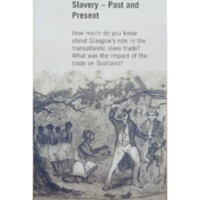
Towards Understanding Slavery: Past and Present
The Towards Understanding Slavery: Past and Present initiative by Glasgow City Council aimed to increase understanding of the human effects of the transatlantic slave trade, and explore its impact on Scotland's national heritage and Glasgow's history. A series of events, exhibitions and education programmes ran across the city throughout 2007. These included an exhibition of William Blake's works relating to the idea of slavery at the Burrell Collection, and a photographic exhibition by Graham Fagen, 'Downpresserer', at the Gallery of Modern Art, examining the cultural heritages of Scotland and Jamaica. There was a series of performances and talks at Kelvingrove Art Gallery and Museum, and events at the People's Palace and Winter Gardens focused on links between Glasgow's tobacco trade and slavery through the family portrait of the 'tobacco lord' John Glassford (there is said to be a figure of a young black man behind Glassford's chair that has been deliberately obscured or painted over). A year-long programme of lectures, schools events and exhibition highlighting the life of African communities in Glasgow took place at St Mungo Museum of Religious Life and Art.
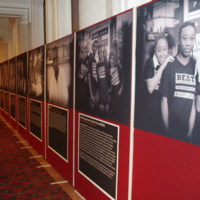
Freedom Roads
The Freedom Roads exhibition at Guildhall Art Gallery was one of several initiatives led by London Metropolitan Archives to mark the bicentenary. The exhibition featured contemporary photographic portraits of people of African origin whose work has contributed to the continuing struggle for human rights in different fields. Colin Prescod, Shirley Thompson, Eric and Jessica Huntley and Rudolph Walker were amongst the individuals featured. Others like the young people from BEAT (Black Experience Archive Trust) were engaged in a project to find out about significant people in their local community. Each person was photographed with an image of an object or place which has a special significance to them. The other part of the exhibition focused on relevant archival materials held by London Metropolitan Archives, including the South African Bill of Rights and a copy of the Constitution signed by Nelson Mandela, Cyril Ramaphosa, F. W. De Klerk and Roelf Meyer. Other material relating to slavery and abolition included a letter from John Julius, a plantation owner on the island of St. Kitts.
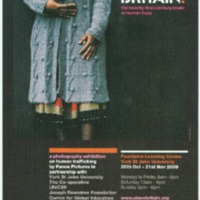
Slave Britain: The 21st Century Trade in Human Lives
This photographic exhibition focused on human trafficking was produced by a partnership of Panos Pictures, Anti-Slavery International, Amnesty International, Eaves and UNICEF. Photographer Karen Robinson’s portraits and tales of women trafficked into prostitution explore the devastating impact on their lives. Also on display were David Rose's panoramic photographs of the ordinary British streets where the stories of modern-day slavery have been played out. The photographs were mounted on a cage-like structure which was specially designed for the exhibition at St Paul's Cathedral. The exhibition was also shown in Edinburgh, Hull and Warsaw, and in 2008, in York.
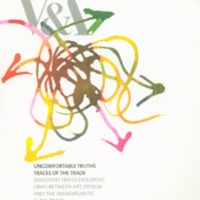
Uncomfortable Truths
Uncomfortable Truths at the Victoria and Albert Museum sought to expose how embedded the transatlantic slave trade was within British culture during the 18th and 19th centuries through art and design. A series of five trails - 'Traces of the Trade' - explored the permanent collections on display through the following themes: Consuming the Black Atlantic, Black Servants in British Homes, Britain and the West Indies, Representing Slavery and Abolitionism, Gold and Slaves Transnational Trade Links. An exhibition of contemporary art examined the impact of the legacies of slavery on modern art and design. The Victoria and Albert Museum commissioned new works by Yinka Shonibare, Romauld Hazoume, Julien Sinzogan and Keith Piper. These and other contemporary interventions by a total of 11 artists were displayed throughout the museum. This exhibition later toured to Ferens Art Gallery in Hull.
The 'Truth and Rights' season of events highlighted often untold stories of Black British heroes, including focus on the actor Ira Aldridge. Visitors were also offered discussions, debates, displays and an eight week free art course. A two-day conference, 'From Cane Field to Tea Cup: The Impact of the Transatlantic Slave Trade on Art and Design' focused on V&A collections took place in February 2007.
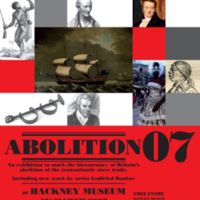
Abolition 07
Hackney Museum's Abolition 07 exhibition told the story of British involvement in the transatlantic slave trade, the resistance to it, and its abolition, and in particular emphasised the involvement of Hackney's residents in the abolition movement. The display included new artwork by Godfried Donkor in collaboration with young Hackney artists. A film of interviews with Hackney residents, Hear My Voice, was produced. Over 1200 children from Hackney Primary Schools took part in poetry workshops at the museum with poets Adisa and Baden Prince. Their poems and responses were published in the booklet 'And Still I Rise'.
The research into Hackney's connections to the transatlantic slave trade continued in 2013-2015 with 'Local Roots / Global Routes', a collaborative project between Hackney Museum and Archives and the Legacies of British Slave-ownership project.
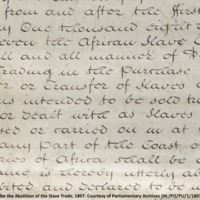
1807: Blake, Slavery and the Radical Mind
A special display at Tate Britain to mark the bicentenary focused on William Blake and the circle of radical writers and artists associated with the publisher Joseph Johnson in the 1790s and 1800s. Blake's poetry and art protested against mental, physical and economic enslavement and inspired generations of artists, writers and political dissenters. The display was accompanied by a variety of events, including talks, performances and music for adults, families and young people and schools.
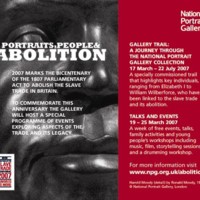
Portraits, People and Abolition
The National Portrait Gallery created a new gallery trail to mark the bicentenary, written by Dr Caroline Bressey. The trail highlighted portraits of key individuals, ranging from Elizabeth I to William Wilberforce, linked to the slave trade and its abolition. Portraits included those who invested in the trade, or who owned slaves and supported slavery, as well as images of enslaved people themselves and of people who were prominent in the movement to abolish the trade. The trail ended with a series of contemporary portraits of individuals involved in preventing slavery today. A week of talks, music, film and family activities included a discussion of the painting 'The Anti-Slavery Convention, 1840' by Benjamin Robert Haydon.
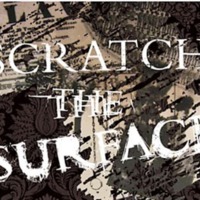
Scratch the Surface
Scratch the Surface at the National Gallery brought together two portraits, Johann Zoffany's 'Mrs Oswald' (1763-4) and Sir Joshua Reynolds's 'Colonel Tarleton' (1782), to explore the complex relationship between these sitters and slavery. Colonel Tarleton, as MP for Liverpool in the 1790s, argued in Parliament against the abolition of the transatlantic slave trade. Mrs Oswald, along with her husband Richard Oswald, owed part of their wealth to a number of plantations in the Americas. The artist Yinka Shonibare was invited to create a new installation in response to these two portraits, which was also on display. A varied programme of events and activities accompanied the exhibition, including tours, talks, workshops and films.
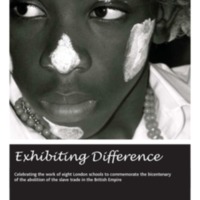
Exhibiting Difference
The Hunterian Museum at the Royal College of Surgeons holds the human and comparative anatomy collections of the surgeon John Hunter (1728-1793). The Exhibiting Difference project was the Hunterian Museum’s contribution to the bicentenary, exploring the history of the transatlantic slave trade through the history of medicine and the experiences of those who lived on the margins of society. Exhibiting Difference focused on the hidden histories of Black Africans living with skin pigmentation conditions in the 18th and 19th centuries, and thus explored issues of identity, self-image and cultural distinctiveness. Curated by Temi Odumosu, the exhibition ‘A Visible Difference: skin, race and identity 1720-1820’ was opened at the Hunterian Museum, featuring portraits of Black African slave children, Mary Sabina and George Alexander Gratton, who both had the skin pigmentation condition piebaldism. The museum also worked with over 200 secondary school students and four professional artists to create a display of sculpture, painting, collage, photography, film and sound recording reflecting the themes of the project. Learning resources were produced to support citizenship education.
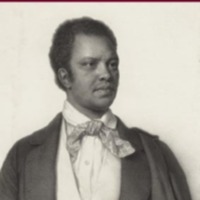
Events to mark the bicentenary in the City of Westminster
In 2007 Westminster City Council supported a programme of events in the libraries, galleries and archives of the area, including films, walks and exhibitions, designed to provide opportunities to learn about the culture of Westminster's communities. Highlights included guided heritage walks with historian S. I. Martin, exhibitions of images from the Royal Geographical Society in Paddington Library, Maida Vale Library and Westminster Reference Library, and film screenings (in partnership with 100 Black Men of London). A partnership between the City of Westminster Archives Centre, Tate Britain, Parliamentary Archives, National Gallery and National Portrait Gallery produced a heritage trail 'On the Road to Abolition: Ending the British Slave Trade', which takes in key sites, events and individuals in Westminster relating to the slave trade, between Trafalgar Square and Pimlico. In celebration of Black History Month, Westminster City Council produced a booklet, 'Black History in Westminster', detailing some of the borough's influential Black residents.
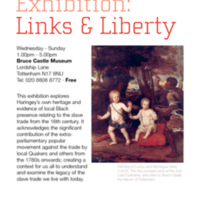
Links and Liberty
An exhibition at Bruce Castle Museum (in partnership with Euroart Studios) explored the transatlantic slave trade, Haringey's heritage relating to the trade and its legacy, and the historic Black presence in the borough from the 16th century onwards. There was a particular focus on the painting of Lucius and Montague Hare, sons of Lord Coleraine (former owner of Bruce Castle), with their African servant. The exhibition also looked at the extra-parliamentary popular movement against the trade by local Quakers such as Priscilla Wakefield and others. Contemporary dance workshops for secondary schools were led by dance company Movement Angol.
The Links and Liberty exhibition included 'Stolen', a life-size installation by artists at Euroart Studios (John Fowler, Lorraine Clarke and Nigel Young) of a section of a slave ship. School pupils were encouraged to climb inside to imagine conditions on board.
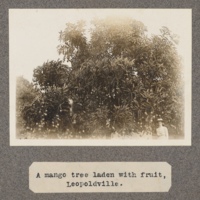
A mango tree with fruit Leopoldville
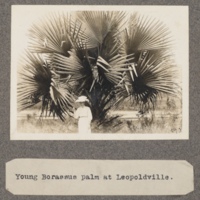
Young Borassus palm at Leopoldville
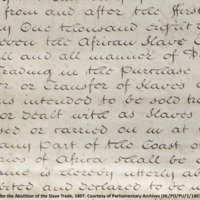
Guernsey and the Slave Trade
A display in the entrance foyer of Guernsey Museum in 2007 explored the island's connections with slavery and the slave trade. Relevant items from the museum's collection included a slave collar and chain from a slaver intercepted by a Guernsey captain on anti-slavery patrols, and a 17th-century portrait of Anne de Beauvoir and a slave child. Guernsey was involved in the transatlantic slave trade via islanders directly involved in the traffic (for example, Thomas Ebworthy of the ship 'Anne Galley'); ships known to be involved, such as the 'African' and the 'Fanny'; and islanders' involvement with the supply of goods or services.